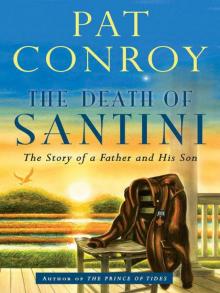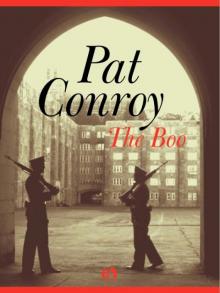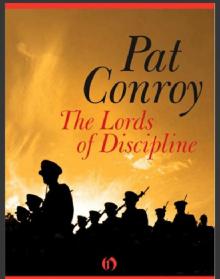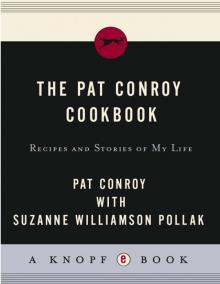- Home
- Pat Conroy
The Pat Conroy Cookbook Page 22
The Pat Conroy Cookbook Read online
Page 22
Terry dug the pit in Cliff’s backyard and stacked up concrete blocks three feet high. He then fashioned a makeshift grill using strong hay wire and rebar, weaving the wire through the rebar, so it did not collapse under the weight of the pig. When I arrived late Friday afternoon, Terry had already started a fire in the fire barrel using several cords of dried hickory, whose smell can induce Proust-like reveries in Southerners everywhere. Terry stacked wood on a grate in the fire barrel, and once the fire was raging, he shoveled out the red-hot ashes that dropped to the bottom of the barrel. Those burning coals, spread evenly about the pit, would cook the pig. It was a continuous process that would go on all through the night.
“Where’s the pig?” I asked as I walked up to the fire.
“It’s in Cliff’s bathtub,” Terry replied.
“Cliff’s Jewish,” I said.
“So?”
“It is my experience that Jews and Muslims are funny about finding pork in their bathtub,” I said.
“It wouldn’t fit in the refrigerator,” Terry explained.
We watched as Cliff drove up with Bernie Schein and Frank Smith, and they walked into Cliff’s house carrying wine and groceries. A moment later, we heard a scream that was both primal and terrified.
“Cliff found the pig,” Terry said.
“Hey, Kay!” Cliff shouted from the back porch. “There’s a pig in my bathroom.”
“I know, Graubart,” Terry said.
“Did you see the one in your bed?” I asked.
“Do you know that I shower in this tub, Kay?” Cliff said. “Tell me the truth. In that hokey poverty-stricken, chicken-growing, cotton-picking, country-song-singing, grits-eating childhood of yours, did you ever put a pig in your parents’ bathtub? Or were you too poor to have a bathtub in North Georgia?”
“We had the creek,” Terry said, winking at me. Then we heard wild, hyenalike laughter coming from the house.
“Bernie found the pig,” I said.
We learned all the secrets of barbecuing a pig that night from Terry Kay. After the pig had cooked for three hours, he began to sop the slow-browning meat with a mixture of water, apple cider vinegar, and salt. With his country-boy knowledge, Terry had made a sop mop by tearing up an old T-shirt and tying the strips around a broomstick. Terry proved to be a vigorous and relentless sopper.
“You’ve got to keep the meat moist, boys,” he said to us. “The rest of the night is going to be dip and sop, dip and sop.”
“This is the most boring thing I’ve ever done,” Bernie said.
“I think this might have been the worst idea any of us ever had,” Frank said. “I vote that we throw Kay out of the group. All in favor?”
All four of us raised our hands in favor while Terry dipped and sopped to his heart’s content. We raised our glasses of red wine and toasted each other and made promises that the group would gather in Italy for a reunion. For an hour, we talked about what our group had meant to us, and the pleasure we took in one another’s company and conversation and the respite it gave us from families and jobs and the great pressures of modern life.
“It hasn’t been all roses,” Bernie said. “This group has had its share of rough times.”
“Name them,” Cliff said.
“There was that time you found a pig in your bathtub,” Bernie said.
“Yeah, and it’s been agony listening about Terry’s deprived childhood,” I said.
“The pain of it,” Bernie said. “I don’t know how any of those poor Kay kids survived.”
“They got by like they always did—dipping and sopping. Just dipping and sopping,” Frank said.
“I get weepy when I think of Terry and his poor family,” I said.
“It’s enough to break a man’s heart,” Bernie added.
Terry roared at us in his gruff, theater-trained voice: “You boys leave my family be.”
“They were godlike people. Godlike Southerners,” Cliff said.
At midnight, I stood up and announced, “Boys, this has been a pleasure, and I have enjoyed every moment of it. But I went to college so I didn’t have to stay up all night barbecuing a hog. If you need me, you can find me in Cliff’s guest bedroom.”
“Why am I sitting against a tree when I could be sitting in a nice armchair in Cliff’s house?” Bernie asked, rising to join me.
“I’m Jewish,” Cliff said. “I’m outraged to find a Methodist cooking treyf in my backyard.”
“In solidarity with Cliff, I’m going to the house, too,” Frank said.
Terry Kay spent the night cussing and turning the pig all by himself. When the hundred guests gathered the next evening, we fed them the best barbecue I have ever eaten. I have never been praised with as much promiscuous gusto as I was for that moist, vinegar-anointed meat from that barbecue in Atlanta over twenty years ago. I found friends moaning over their paper plates, and people returning for seconds and thirds. A sensitive man, Terry Kay, who was not talking to any of us because of his justifiable anger at our defection, left the party early. I heard a woman ask Bernie who cooked the pig, and was not surprised when he answered, “I did. Pat and Frank and Cliff helped.”
Cliff caught the spirit quickly, and said, “I’m exhausted. We were up all night.”
“None of us have slept for twenty-four hours,” Frank added.
“Terry Kay told me that he cooked the pig,” the woman said.
The four of us laughed and shook our heads. Then I said, “Give Terry credit, boys. It was his idea, but we stayed up to cook the pig. Terry Kay went to bed.”
PORK—PIECE BY PIECE
There are five major sections of a pig:
Leg, where the fresh ham comes from
Loin, where almost everything else meaty and tender comes from, roasts and chops and tenderloin strip
Side, source of bacon and spareribs
Shoulder/butt, provides shoulder roast (sandwich meat) and smoked butt
Picnic shoulder, the smoked picnic roast and smoked hocks
STUFFED PORK CHOPS I was not a great and fervent fan of pork chops until I used this recipe. I discovered I loved these pork chops when I gussied them up and sent them to finishing school.
Four 1½-inch-thick rib pork chops (about 1 pound each)
Stuffing (see below)
1 tablespoon unsalted butter
1 tablespoon olive oil
1 cup white wine or chicken stock
¼ cup tangy grainy mustard
½ cup heavy cream
1. With a small sharp knife, make a horizontal pocket in the meat side of each chop, deep enough to hold the stuffing without puncturing the top or bottom of the chop. (The pocket should be almost to the bone.) Fill with just enough stuffing to keep the pocket slightly open (¼ to ⅓ cup per chop; the stuffing should be compressed so that it sticks together).
2. In a large skillet with a tight-fitting lid over medium-high heat, melt butter and oil until foamy. Brown the chops, turning only once, for about 3 minutes on each side.
3. Reduce the heat to low, cover the skillet, and cook the chops until medium well done, about 8 minutes per side. (Or brown the chops on top of the stove and finish the cooking in a preheated 350°F oven for 15 to 18 minutes.) To check for doneness, make a small slit near the bone with the tip of a paring knife and peek inside, or check with an instant-read meat thermometer inserted near the bone; it should read 115°F.
4. Transfer the pork chops to serving plates, letting them rest for about 5 minutes to let the natural juices redistribute. While chops are resting, deglaze the pan with the wine, stirring well to scrape up any browned bits. Bring to a low boil and reduce by half. Stir in the mustard and slowly whisk in the heavy cream until well incorporated and sauce is thick enough to coat the back of a wooden spoon.
5. Spoon the sauce over the chops and serve, passing extra sauce on the side.
Stuffing • Makes about 2 cups
4 thick slices smoky bacon, coarsely chopped
2 shallots, finely
chopped
2 tablespoons olive oil (optional)
2 cups cleaned greens, such as mustard greens, kale, or collard greens, cut into long, thin strips
½ cup Pepperidge Farm Corn Bread stuffing
1. Warm a heavy skillet over moderate heat. Add the chopped bacon and cook until fat is rendered and bacon is almost crisp, about 10 minutes. Remove and reserve bacon (leaving behind as much bacon fat in the pan as possible).
2. Sauté the shallots in the bacon fat (if there is not enough, add olive oil). When the shallots are soft but not yet browned, about 2 minutes, add the greens. Cook over medium-high heat until greens are wilted, 3 to 5 minutes for collard or mustard greens, up to 10 minutes for kale.
3. Remove from the heat and add the reserved bacon and the stuffing. Stir to combine.
CANDIED BACON One cannot make bacon in a way that I could not like it. This recipe brings elegance and sweetness to an already fabulous product. The recipe approaches decadence, like putting perfume on a pig. • SERVES 2
6 thick slices bacon
1 tablespoon light brown sugar
1 teaspoon Dijon mustard
1. Preheat the oven to 375°F.
2. Arrange the bacon on a sturdy baking sheet. Place a smaller baking sheet on top of the bacon: the weight of the top pan will keep the strips flat while they cook.
3. Bake until almost crisp, about 20 minutes.
4. In a small bowl, mix the sugar and mustard together into a lumpy paste.
5. Remove the bacon from the oven and transfer (draining the grease) to a clean baking sheet. Using the back of a spoon, coat the top of each bacon strip with the mustard mixture. Return to the oven for 5 more minutes. Remove the bacon, turn the slices over, and repeat. Bake until the bacon looks brown and lacquered, about another 5 minutes.
6. Using tongs, remove the bacon and set on a rack over paper towels to drain. Serve warm.
COLLARD GREENS Collard greens are soul food pure and simple. In 1971, while living near San Francisco, I had a car cut me off and wave me down while I was driving through the Presidio. A huge black man got out of his car and approached my own. Oh, oh, I thought, he saw my South Carolina license plate and has decided to kill me because of the crimes my people committed against his people. But he surprised me with his large magnetic smile. I got out of the car and we shook hands.
“Where you from in South Carolina, man?” he said.
“Beaufort,” I answered.
“Man, I’m from Charleston. Don’t you miss the Low Country?”
“More than I can tell you.”
“I saw your license plate and I just had to talk to someone from home.”
We talked for fifteen minutes and he told me the names of three soul food restaurants that served good collard greens, fried chicken, and pot likker—two in Oakland and one in San Francisco. He told me he prayed every day for a good-paying job to open up in Charleston and that he was worried about raising his children among the “hippies and wackos.” He missed fishing for bream in the Edisto River and going after blue crabs with string and a chicken neck. Everything I loved about the South was contained in this ebullient homesick man. He told me the name of two Baptist churches in San Francisco. “The old-time religion. Man, these people believe some weird shit out here.” He embraced me when we said goodbye, and as he drove off I regretted not getting his name and address. I would have liked to have been his friend for the rest of my life. This recipe is dedicated to him. • SERVES 4
4 ounces salt pork, diced
1 tablespoon olive oil
1 medium onion, coarsely chopped (about ¾ cup)
One 1-pound smoked ham hock or country ham bone
4 pounds collard greens, picked over and cleaned, with stems removed and leaves cut into 1-inch strips
One 35-ounce can whole tomatoes, preferably San Marzano, broken up into small pieces and drained
1. To make the pork stock: In a medium, at least 8-quart stockpot over moderate heat, sauté the salt pork in the oil until lightly browned, 6 to 8 minutes. Add the onion and cook until the salt pork is crisp and the onion is well colored, 8 to 10 minutes. Add 3 quarts water and the ham hock. Bring to a boil, turn down the heat, and simmer slowly (so the surface of the liquid has some movement) until the water is infused with flavor, at least 1 hour or up to 2. Remove ham hock, cool, and strip the meat from the bone (reserve the meat for Pot Likker Soup, page 226). (The pork stock can be cooled to room temperature, transferred to a storage container, and refrigerated overnight.)
2. Add the collards and tomatoes to the pork stock and cook on medium heat until the greens are wilted, 30 to 40 minutes. Serve hot.
SOUTHERN RATATOUILLE WITH BACON This is called Southern ratatouille because it contains bacon. Southerners cannot seem to cook anything without flavoring it with some part of a pig. I still cannot spell or pronounce ratatouille, even with the bacon in it.
• SERVES 1 AS A MAIN COURSE OR 2 AS A SIDE DISH
2 thick slices bacon, coarsely chopped
1 large red onion, finely chopped (about 1 cup)
2 garlic cloves, finely chopped
2 small zucchini, peeled and diced into ¼- to ½-inch cubes (about 1½ cups)
2 small yellow squash, diced into ¼- to ½-inch cubes (about 1½ cups)
1 large ripe tomato, coarsely chopped (about 1½ cups)
1 cup fresh corn kernels (about 2 ears)
Chopped fresh chives, thyme, basil, or mint
1. Warm a large heavy skillet over moderate heat. Add the bacon and cook until fat is rendered and bacon is just crisp, about 5 minutes. Add the onion and garlic and continue cooking over medium heat until the onion is softened and begins to brown.
2. Raise the heat to moderately high and add the zucchini and squash. Cook, stirring occasionally without turning, until lightly browned but still crisp-tender, 5 to 8 minutes. Stir in the tomato and cook until softened, translucent, and beginning to break apart, about 5 minutes. Add the corn and cook, stirring frequently, for another 2 minutes. Add the herbs and mix gently. Serve at once.
POT LIKKER SOUP
I used to order pot likker every time I went to eat at Mary Mac’s in Atlanta, a sacred institution of Southern cuisine on Ponce de Leon Avenue near Peachtree. The simplest version of pot likker is this: cook a bunch of greens with a goodly portion of fatback, pour the liquid into a bowl, and serve it. A shake of pepper vinegar livens it up. It calms a Southerner’s nerves and brings a sense of order back to the world.
This is a simple, rough country soup; don’t even try to fancy it up. Remove the fat from surface of refrigerated pork stock (page 225). For each serving, bring 1 cup pork stock to a low boil. Add 2 canned tomatoes (break up the tomatoes with your fingers), some cooked collard greens, and a sprinkling of salt pork. Simmer the soup for a few minutes, then sprinkle with shreds of meat from the ham hock and serve with corn bread on the side.
PORK BUNS •MAKES 8
3 cups unbleached all-purpose flour
2 teaspoons baking powder
1 teaspoon salt
½ cup boiling water
Olive oil
Pork Filling (see below)
1 cup crumbled blue cheese
Chutney
1. Place the flour, baking powder, and salt in the bowl of a food processor and pulse to combine. With the motor running, add the boiling water and then add ½ cup plus 2 tablespoons cold water in a thin stream until the mixture forms a ball. Process for 1 minute longer and turn the dough out onto a floured surface. Knead briefly, cover with plastic, and let sit for 15 minutes.
2. Divide the dough into 8 equal pieces. Working with one at a time (leaving others covered), roll the dough into an 8-inch circle and brush with a little olive oil.
3. Spread one-eighth of the pork filling and one-eighth of the crumbled cheese evenly on the dough, leaving about a ½-inch border around the edge. Roll the dough up like a jelly roll, as tightly as possible. Holding one end of the resulting tube on your work surface, pu
ll the other end around as tightly as possible and pinch the two ends together, making a smooth round. Repeat with the remaining dough. As you fill each bun, place it on a baking sheet and cover with plastic wrap. (The filled buns can be cooked immediately or covered with plastic wrap and refrigerated for up to 2 hours. Bring to room temperature before cooking.)
4. Preheat oven to lowest setting.

 A Lowcountry Heart: Reflections on a Writing Life
A Lowcountry Heart: Reflections on a Writing Life The Death of Santini: The Story of a Father and His Son
The Death of Santini: The Story of a Father and His Son The Boo
The Boo The Prince of Tides
The Prince of Tides Beach Music
Beach Music The Water Is Wide
The Water Is Wide My Losing Season
My Losing Season The Lords of Discipline
The Lords of Discipline Pat Conroy Cookbook
Pat Conroy Cookbook My Reading Life
My Reading Life My Exaggerated Life
My Exaggerated Life The Pat Conroy Cookbook
The Pat Conroy Cookbook A Lowcountry Heart
A Lowcountry Heart The Death of Santini
The Death of Santini